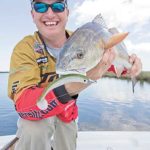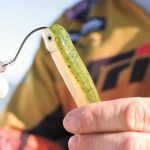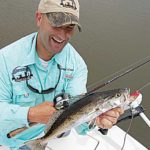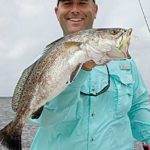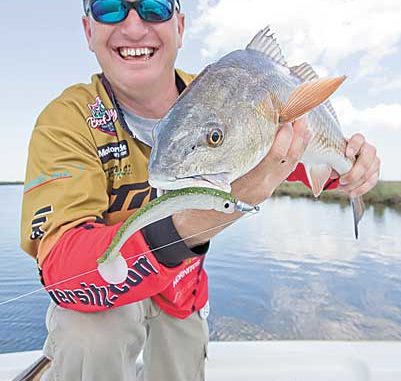
Bass pros started the swimbait craze, but it didn’t take long for saltwater anglers to realize these chunky baits are irresistible to speckled trout.
It wasn’t that long ago, a year maybe, that Capt. Charlie Thomason started to notice a growing trend every time he saw a bass tournament on TV. The guys throwing swimbaits were blowing away the field by catching monster bass.
He silently wondered if swimbaits would work for saltwater fishing, and he snuck into the freshwater aisle every now and then to buy a bag.
The idea of fishing big swimbaits was still spinning in his head when he arrived at a redfish tournament at Port Arthur, Texas. He pulled out a bag of his newly acquired bass baits, and started throwing them as far as he could.
As the redfish started torpedoing from as far away as 20 feet to attack, Thomason couldn’t help but wonder what the big speckled trout back home might think of them.
“I knew there was something special about swimbaits the moment I first threw one,” he said. “It wasn’t long after that tournament that Robin Shiver with Bass Assassin came out with some 6-inch swimbaits, and I got some in the new penny color. The first time I tried them for trout was out on the rigs.”
Being that he was already on fish, Thomason threaded the giant Assassin swim bait on to a 3/8-ounce jighead just to see what it would do. After casting it out, he let it sink to the bottom before beginning a slow and steady retrieve. The result was exactly what Thomason was hoping for. His big swimbait not only caught fish — it caught bigger fish.
About the same time that Thomason was learning how good big swimbaits could be for big speckled trout, Capt. Marty LaCoste was learning a similar lesson about 90 miles to the east around Last Island below lower Bayou DuLarge. LaCoste was struggling to catch fish, so he started digging around in his boat to find a bag of Tsunami Swim Shads that he just happened to purchase a few days before.
“It was frustrating,” LaCoste recalled. “I knew the fish were there, and I could see what they were eating, but I couldn’t get them to bite. I tied on one of the small Tsunami swim baits; it was chartreuse with a blue back. I remember it looked exactly like the baitfish I could see in the water.”
LaCoste fell in love with small swimbaits just as quickly as Thomason had fallen head-over-heals for the big ones.
For Thomason, his swing-for-the-fences mentality means he is willing to catch fewer but bigger trout. On the other hand, LaCoste says he’s just trying to put fish in the boat with the smaller swimbaits. Whichever mentality you have, swimbaits are here to stay, so it’s in your best interest to learn how to fish them.
If you’re after big trout, Thomason says there are two important considerations that should signal it’s time to throw swimbaits. First, he insists they are at their best when fished in areas that already hold good schools of mullet. Secondly, swimbaits become a primary choice when fishing areas that are capable of holding big fish.
“When you go out on the edges of the Gulf, you know the majority of the fish out there have to be pretty big to survive,” Thomason said. “The fish on the edges are more aggressive when it comes to eating, and there always seems to be lots of mullet. And any time big fish are keying in on big mullet is when I’m going to be throwing a big swimbait.”
Although Thomason believes swimbaits are at their best on the edges of the Gulf, he is quick to add they work extremely well in any bayou, bay or pond that is holding big trout. In fact, his eye-opening first experience with big swimbaits was out on some of the rigs in Breton Sound.
“And that’s one of the great things about swimbaits,” he said. “They are a great big-trout bait, but they are also versatile enough to fish everywhere from shallow ponds to deep rigs. All you’ve got to do is adjust how you fish them.”
No matter how deep he fishes swimbaits, Thomason has found the best all-around way to rig them is to Texas rig on at least a 3/8-ounce jighead. Texas rigging makes them less prone to hang-ups, and a heavier jig is required to pull the bulky bait to the bottom. Thomason doesn’t stop with a simple Texas rig, though.
“I was sitting around with my guides one day discussing how to make these things better,” he said. “We were getting a lot of bites where the trout were just pulling the bait off the hook.
“Our idea was to tie a No. 2 treble hook stinger to the eye of the jig with about a 4-inch length of 30-pound test Power Pro. We learned that barely sticking one of the hooks into the plastic so the other two were sticking straight up worked best. It’s not weedless, but it made our catch ratio go way up.”
When fishing shallow water, Thomason rigs his swimbaits with no weight when he’s fishing way back in the ponds. This allows him to work his lure over the grass. Out along the edges, he generally rigs with a 3/8-ounce jighead. And out in deep water, he goes with at least a 1/2-ounce weight.
In the shallow ponds, Thomason’s most productive retrieve is burning his swim bait quickly near the surface. Big trout love striking at something that looks like it’s trying to get away, and that’s exactly what a fast-moving swim bait mimics.
However, as he moves to deeper water near the edges and out on the rigs, Thomason makes as long a cast as he can, and he lets his swim bait sink all the way to the bottom. Then he begins a slow and steady retrieve that pulls the bait just off the bottom. As the bait naturally rises to the surface the closer it gets to the boat, Thomason pays attention to any strikes in that sweeping zone.
“If I start getting bit off the bottom, I’m going to start counting down my bait to that depth and start reeling without it ever getting to the bottom,” he said. “However deep you’re fishing them, though, you’ve got to keep these kinds of baits moving. They’re not made to hop off the bottom; they’re made to swim.”
While the larger swimbaits like the Bass Assassin Swim Bait and the Yum Money Minnow perfectly resemble a mullet swimming through the water, LaCoste feels his favorite Tsunami swimbait more closely imitates a pogie. The Tsunami Swim Shad is short, but it has a wide profile respective to its length.
“These soft-plastic swimbaits look way more natural than all the cocaho tails out there,” said LaCoste. “I’ve thrown just about every color that Tsunami makes, and every one of them appears exactly like a little pogie swimming through the water — it’s identical.”
LaCoste feels that small swimbaits are at their best in the waters around lower Bayou DuLarge throughout the winter and spring until about May. As ultra-realistic as these swimbaits are, LaCoste says they aren’t as effective fished on a tandem rig, a mainstay in the waters of southern Terrebonne Parish throughout the summer.
“Any time I want a single bait, I’m throwing the swimbait,” LaCoste said. “Most of the time around here, that’s the winter because that’s when our trout are in shallow water over reefs. When they school up, it’s just too hard to put the tandem rig down. But if you go down around Last Island, you can catch trout on swimbaits even when everybody else is throwing tandem rigs.”
Around Last Island, LaCoste recommended throwing the Tsunami Swim Shads over the underwater gullies that run parallel to the shore. Big trout roam around in these depressions, and they’ll readily come up to attack a swimbait as it crosses over their heads.
“You kind of control how deep you’re fishing it by raising or lowering your rod tip,” LaCoste said. “Keep your rod tip down if you’re fishing in deep water, and keep it up if you’re in shallow water. Sometimes around Last Island, they’ll attack it as soon as it hits the water, though. And you might think they would eat anything in that case, but I’ve seen it where they would only eat the swimbaits when they wouldn’t touch anything else.”
Whether large or small, there isn’t any difference in how swimbaits work. Throw them out and reel them in. It can’t get much simpler than that.
However, Thomason was quick to caution against overlooking the big ones because of their size. These things catch fish, but they’re going to require a little bit different way of thinking on your part.
“When most people see a bait longer than 5 inches, they think it’s too big,” Thomason said. “We’ve become accustomed to racks of small soft plastics that do a great job of catching fish that we get intimidated by the big ones; they look larger than life to us, so we leave them on the shelf.
“Think of it like this. When you see mullet in the water, it might not look like it to you, but they are probably 5 to 7 inches long, and trout have no problem eating them.”
If swimbaits are so good, can we throw everything else out of our boxes? Thomason says no. Rather than replace our old favorites, swimbaits supplement them. Fishing them will, however, replace your old way of thinking. Do you want to catch 20 fish that weigh 20 pounds, or do you want to catch 10 fish that weigh 40?
Contact Capt. Charlie Thomason at (504)-278-FISH and Capt. Marty LaCoste at 985-856-4477. Follow the author’s blog at www.chrisginn.com.
